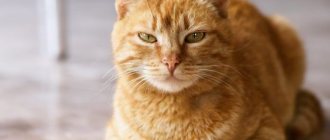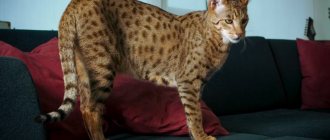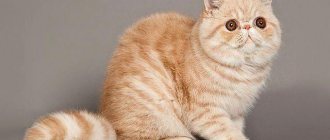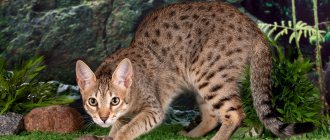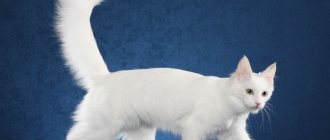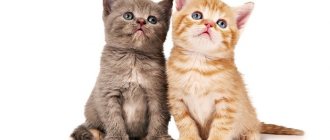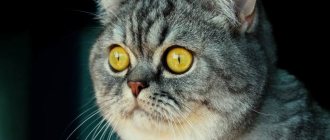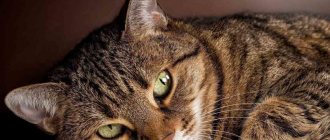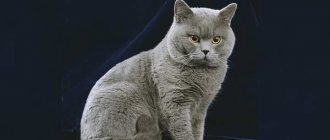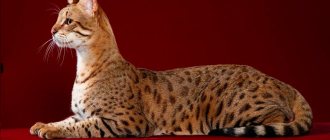Description and photo of oncilla
Natural living conditions for a tiger-colored cat are tropical and subtropical forests and eucalyptus thickets. An adult oncilla is very similar to a baby jaguar due to almost the same color. Among its relatives, the tiger cat is the smallest and most similar in size to ordinary domestic cats. Its weight does not exceed 3 kg, body length - 60–65 cm. The body is muscular, the head is round, small, with an extended muzzle. Relative to the head, the ears are quite large, without tassels at the ends, and erect. The inner surface of the ears is light, has a sparse edge, while the back part is black with a white spot.
The eyes are very large, stand out on the muzzle, have vertical narrow black pupils, and the eye color is yellow-brown. The tail is of medium thickness, up to 40 cm in length. Paws with long and sharp claws, and the hind legs are slightly longer than the front ones. The cat's ocher fur is very soft, although short. The entire body, except the belly and chest, is covered with dark ring-shaped spots of dark color and irregular shape. The chest and belly are covered with white hair. On the tail, the spots turn into transverse lines, which form a solid dark-colored spot at the tip of the tail.
Did you know? 20% of oncilla babies are born completely black.
They are called melanists; they differ from their relatives only in the color of their skin and produce healthy offspring.
Oncilla
Oncilla
Beauty! An exact copy of a jaguar, only small. This is an eighty-centimeter animal with beautiful spotted fur, a cute face with round ears and big eyes. Oncilla lives in moist evergreen forests of Central and South America. It feeds on rodents, birds, snakes, frogs and small monkeys.
Beneath its pretty and very attractive appearance lies the wild and unbridled character of the oncilla. Animals are very aggressive and are not afraid to fight large predators, and often defeat them.
Oncillas are being exterminated for their beautiful fur, and their population is also declining due to human development of their habitats. Some people keep oncillus at home.
Character and lifestyle
Oncilla is a secretive animal that prefers a solitary lifestyle. These cats hunt and live alone, and only during mating and raising offspring do they change their habits. It is very rare for a person to see an oncilla in the wild, since it is active only at night and avoids people. During the day, the cat sleeps on tree branches, which it uses not only as a place to sleep, but also as shelter from enemies, and also as an observation point during the hunt.
She can sit in a shelter for hours and stalk prey, after which, at an opportune moment, she pounces and gnaws its throat. This cat has long and strong fangs. Since it is a nocturnal animal, it has excellent vision and hearing. The cat jumps beautifully, climbs trees and even swims.
Important! Oncillas are aggressive, especially if they are hungry. They do not harm humans, but they can attack any animal, even larger than them.
Breed Kodkod
The Kodkod is another species of wild cat that resembles a small jaguar in its appearance. The Kodkod or, as it is also called, the Chilean cat (Oncifelis guigna, Felis guigna) is the closest relative of the oncilla, although it is somewhat different from it in appearance.
- Appearance.
The size of this representative of the cat family is almost half the size of the oncilla. The maximum body length is only 52 centimeters. Maximum body weight - 2.7 kg. The Kodkod is the smallest wild cat in South America. The Chilean Kodkod is similar in appearance to the Oncilla, but is distinguished by a denser build and heavier skeleton, a browner or grayish-brown coat color and finer spotting. Sometimes it is even completely black. - Distribution area and habitat.
The Chilean cat lives mainly in the southwestern part of South America, in the central and southern part of the state of Chile (hence the name of the species) and slightly in Argentina. In nature, it is found in temperate-humid and coniferous forests of the South American continent, in areas of hard-leaved shrubs, near rivers and lakes. Sometimes these animals can be found near human habitation (especially in quieter areas where deforestation and hunting are not carried out). - Lifestyle.
Kodkod is a solitary predator, usually going out to hunt at dusk. However, if the places are quite protected, he can hunt during the daytime. The Kodkod's diet consists mainly of small rodents and birds. Sometimes - non-poisonous reptiles and some insects. It is not uncommon for domestic geese, ducks and chickens to become victims of kodkod. The lifestyle of this cat is very secretive and has not yet been sufficiently studied. It is only known that these animals spend most of the day in tall trees, descending only to hunt or to mark their habitat, the size of which reaches up to 2.5 square meters. km. In low-growing forests and shrubby undergrowth, the kodkod hides in the thickets during the daytime or makes a den for itself in gullies and ravines. Sexual maturation of representatives of this species occurs at approximately 2 years. Pregnancy in females lasts on average 73–78 days. In a litter, from 1 to 3 kittens are born, which are fed with milk for up to 3 months. Life expectancy, even under good conditions in captivity, is relatively short - 10–11 years. In nature, even less is expected. - Enemies.
This wild cat has no natural enemies. It's very difficult to catch him. Therefore, the main problem for the population of this amazing animal is human deforestation for coffee plantations, as well as poaching for the sake of the animal’s beautiful skin. Kodkods are often killed by farmers in revenge for exterminated poultry, and sometimes these animals become accidental victims of hunting foxes or rabbits with dogs. - Keeping in captivity.
Kodkods are difficult to tame and are therefore kept in cages and enclosures in captivity.
How to choose a small spotted kitten
The cost of purchasing such an animal may depend on many factors: pedigree, color, beauty of the design. It is worth noting that the tiger cat is considered a rare species, so it is better to purchase it not from hand, but from a specialized nursery. Only there the kittens are raised using special technologies and have documents for each animal with information about their health status and vaccinations. Specialists also solve problems that may arise when a kitten adapts to new conditions, and help to tame and educate it.
The cost of a pet fluctuates around $2000.
Features of keeping at home
Oncilla is a predator that is distinguished by its obstinate character, nocturnal lifestyle, great jumping ability and love of solitude. All this must be taken into account when purchasing such a pet. It is best for a cat to have a separate enclosure that will resemble its natural living conditions. If you just want to keep a predator in the house, then keep in mind that all other small animals living there will be perceived by it as legal prey.
Important! If there is an oncilla in the house, then there should be no small children there, and all windows should be covered with bars or metal mesh, otherwise the cat may simply escape.
Features of care
This wild species does not require any special care, but do not forget that regular visits to the veterinarian are an essential factor in the growth of a healthy and well-groomed kitten. Of course, wild cats at home need proper and regular nutrition, education and free space.
Did you know? The life of a tiger cat at home is much longer and more comfortable than in the wild. Under natural conditions, oncillas do not live up to 15 years, but in captivity, some individuals lived up to 20 years.
Geoffroy's cat
And another mini jaguar of South America is Geoffroy’s cat (Leopardus geoffroyi, Felis geoffroyi, Oncifelis geoffroyi), named after the discoverer of this species, the French naturalist Geoffrey Saint-Hilaire.
It is also closely related to the oncilla minijaguar. At the moment, four subspecies of this animal living in different regions have been described:
- Felis geoffroyi geoffroyi - in central Argentina;
- Felis geoffroyi Paraguayae - in Southern Brazil and Uruguay;
- Felis geoffroyi Euxantha - in Bolivia;
- Felis geoffroyi Salinarum - in the Chaco region.
Description of the breed:
- Appearance.
This animal is very similar to the oncilla already described above, differing only in its slightly smaller body size and much greater mass (due to its massive skeleton). The body weight of the wild cat Geoffroy reaches almost 5 kg in males and up to 4 kg in females. Body length is from 45 to 75 centimeters. The color of the animal is golden yellow with a distinct black pattern combining spots, circles, stripes and rings. It is not uncommon to encounter completely jet-black individuals. - Distribution area and habitat.
Geoffroy's cat is distributed in the south of South America - in southern Brazil, southern Argentina and southern Patagonia. The habitat covers forested areas of the foothills and low mountains, pampas, saline deserts, areas of small forests, dense bushes and even swamps. Geoffroy's cat is a fairly versatile animal, capable of successfully surviving in areas with different natural conditions and climates. This animal rarely coexists with humans. - Enemies.
The main enemy of this animal is man, who not only hunts it for its beautiful fur (currently, hunting and trade in these animals is prohibited everywhere), but also destroys its natural habitat, draining swamps, cutting down forests and shrubs. These animals have no natural enemies that can harm the population. - Keeping in captivity.
Adult wild cats of this species are difficult to tame. It is only possible to “domesticate” kittens for a while; as they grow up, they still acquire all the habits and habits of their wild counterparts. Therefore, it is necessary to keep such pets with the utmost care, avoiding carelessness. - Lifestyle.
Geoffroy's cat, like most representatives of the cat family, leads a solitary lifestyle. Hunts on the ground, trees, bushes or near water bodies, mainly in the dark. Hunting trophies include not only small rodents and birds, but also guinea pigs, agouti, reptiles, insects, bird eggs and river fish. The animal swims well and is not at all afraid of water. It happens that these animals also attack small domestic animals (which is why affected farmers often hunt them themselves). During the daytime, this mini jaguar prefers to hide in a bush or tree (in a wooded area). It necessarily and regularly marks its habitat areas. The usual plot size ranges from 4 to 10 square meters. km. - Puberty
in cats of this species occurs at the age of two. Mating usually takes place on a tree. In forest areas, newborn kittens are subsequently placed there (usually in a hollow). In treeless areas, Geoffroy's cat makes secret lairs in thickets or rock crevices. From 1 to 3 kittens are born in a litter (usually there are up to two litters per year). Lactation lasts about three months, after which the offspring switches to solid meat food. - The lifespan
of these beautiful animals in nature is not long, but in captivity they sometimes live up to 14 years.
Reproduction
Females enter the sexual maturity phase at one year of age, and males at one and a half years of age. The most active breeding season occurs in February and March. Estrus lasts for several days, which are accompanied by stormy mating games - loud screams and fights. Pregnancy lasts 75–80 days (about 2.5 months). Most often, the number of cubs born does not exceed 1 or 2, they weigh about 100 g and are born blind. Only on the 20th day after birth do kittens’ eyes open.
A tiger cat feeds its offspring with milk for 3 months, and when their teeth erupt, they gradually switch the babies to meat food. Kittens practically cease to depend on their mother at 3.5–4 months, at which time they already eat only solid food. 11-month-old cats are considered adults.
